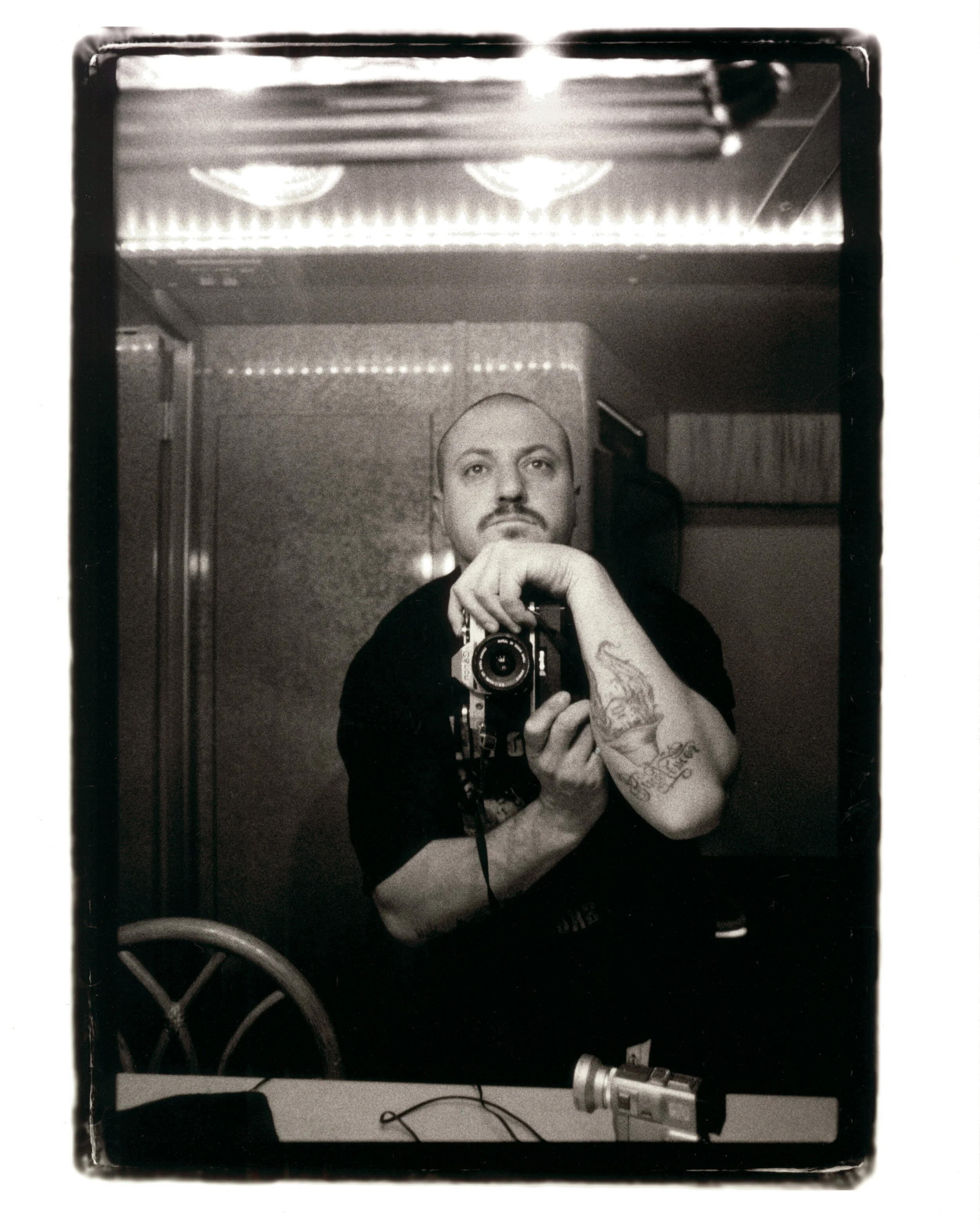Image via Estevan Oriol
“If you ain’t been tatted by Cartoon you ain’t got no tatt, if you ain’t been shot by Estevan then you got a weak ass photographer”. The recent Netflix documentary LA Originals, directed by Estevan Oriol, depicts the lives of famous photographer Estevan Oriol and tattooer Mister Cartoon. Often something that is overlooked when discussing the 90’s Hip Hop scene, is the major contribution from those working behind the scenes. Prior to this digital age dictated by social media likes, clout chasers and mumble rappers, Los Angeles was an extremely different landscape. While tattoos are widely accepted today, back then only those deemed outcast were brave enough to permanently brand their skin. The most reputable of these Tattooers Mister Cartoon, was known for his elaborate graffiti-inspired style brought to life in black and grey. He has tattooed every one from gangsters, to A-list celebrities. This dynamic downtown lifestyle was caught on film by photographer Estevan Oriol. LA Originals does a great job of showing how these artist documented this culture-shifting period, and helped visualise what it was like to live in Los Angeles during the 90s.
Oriol is an American of Italian and Mexican descent. He started his career as a hip-hop club bouncer turned tour manager for popular Los Angeles-based rap groups Cypress Hill and House of Pain, Estevan’s passion for photography developed while travelling the world. With an influential nudge and old camera from his father, renowned photographer Eriberto Oriol, Estevan began documenting life on the road and established a name for himself amid the emerging hip-hop scene. He soon became an internationally celebrated professional photographer, director and urban lifestyle entrepreneur.
Estevan Oriol
Image via Estevan Oriol
His counterpart Mister Cartoon began his career as a graffiti artist before branching into murals, album covers, logos, and now most famously known for his tattoos. Since the age of eight, Mister Cartoon realized he was an artist and went on his first paying art job at the age of twelve. Having grown up in the Harbor Area of Los Angeles County, young Cartoon began airbrushing T-shirts and lowrider cars before adopting the legendary"Fineline Style" tattoo art, which was developed in the California prison system. In an interview with No Jumper Cartoon explains how he had “two middle class parents that worked allot… with them gone I went into the streets … my dad was always a hustler and had vintage cars, you know we were a regular mexican middle class family growing up in southern california”. He also elaborated how “In the Harbour you have two choices, you can be a longshoreman or sell dope… in the 80’s gangbanging was at an all time high and your own people preyed on you, and i got fortunate that i love to draw and do graffiti, I started to learn how to use artwork to manipulate the situation”. This upbringing clearly rubbed of in his art. His richly detailed, hand-rendered designs pull much of their inspiration from the Los Angeles of Cartoon’s youth. At one time, the black and grey, fine line style was synonymous with LA street life. Cartoon’s work has helped bridge the gap between those hardscrabble beginnings and the style’s current popularity
Mister Cartoon
Image via thehundreds.uk
Image via mistercartoon.com
Image via mistercartoon.com
Together the two would go on to found SA(Soul Assassins) Studios Global, a lifestyle-marketing agency based in Los Angeles. SA has partnered with companies such as Microsoft, Nike, Vans, Stussy, Metro PCS, Rockstar Games, and Harley-Davidson and taken part in film marketing projects with Fox, Weinstein Company, and Universal. With both Estevan Oriol and Mister Cartoon being heavily entrenched in Hip Hop culture, they would go onto tattoo and photograph some of the biggest names in Hip Hop and most iconic celebrities. Oriol has photographed Al Pacino, Robert Dinero, Dennis Hopper, Ryan Gosling, Chloe Moretz, Marissa Miller, Kim Kardashian, Kanye West, Snoop Dogg, Floyd Mayweather, and others. He has also produced shoots for internationally-acclaimed photographers such as Ellen von Unwerth for Sang Bleu and Luca Babini for GQ Italy. In addition to shooting campaigns for companies including Cadillac, Nike and Rockford Fosgate and directing new media projects for My Cadillac Stories, MetroPCS, MTV and Apple, Oriol has designed album covers and directed music videos for artists including Eminem, Cypress Hill, Blink 182, Snoop Dogg and Xzibit. Cartoon’s work has helped bridge the gap between those hardscrabble beginnings and the style’s current popularity. Stars such as Eminem, Travis Barker, Slash, Dr. Dre, 50 Cent, Beyoncé, along with athletes like CC Sabathia, Amarie Stoudemire and Carlos Boozer wear Cartoons art on their skin. Cartoon’s art has been featured in numerous publications including Rolling Stone, The Wall Street Journal, Complex, Juxtapoz, XXL, GQ, and others. Most notably the pairs influence can be heavily seen in Rockstars Iconic GTA San Andreas, with their artistic style being referenced heavily to bring the virtual world to life.
Image via Estevan Oriol
Image via Estavan Oriol
Image via Estavan Oriol
Image via Estevan Oriol
Image via Estevan Oriol
Image via Estevan Oriol
One of the elements that is heavily represented in their work is their heritage. Mexicans have had a long relationship in the US. Mexican Americans in 2018 made up 11.3% of the United States' and 61.9% of all Latinos in the United States. Over 60% of all Mexican Americans reside in the states of California and Texas (which used to be part of Mexico and today still shares a border). Mexican American families of indigenous heritage have been in the country for at least 15,000 years, and mestizo Mexican American history spans more than 400 years, since the 1598 founding of Spanish New Mexico. They would become U.S. citizens in 1848 via the Treaty of Guadalupe Hidalgo which ended the Mexican–American War. In particular Los Angeles (spanish for ‘The Angles’) has a thriving Hispanic community. Cholo and Chicano became a chosen identity for Mexican Americans in the United States. Although Chicano had negative connotations as a term of denigration prior, it was reclaimed in the 1960s and 1970s by Mexican Americans to express self-determination and solidarity in a shared cultural, ethnic, and communal identity while openly rejecting assimilation. Both Estevan Oriol and Mister Cartoon played a huge role in bringing Chicano pride and the wider downtown culture to the mainstream. Estevan says in the LA Originals documentary that “one of the things that is there with Chicano art is violence, poverty, addiction, and alcoholism”. With both artist living through the 1992 Rodney King Riots, and the crack epidemic there is no doubt that their environment deeply impacted their art. Estevan explains “I was shooting a lot of women, gangsters and lowriders you know because that is what I was around”.












Images via Estevan Oriol
This unique LA culture is best encapsulated in Mister Cartoons collaborations with Nike. With Los Angeles being considered the home of cortez since day one, the ‘2005: MR. CARTOON CORTEZ’ was bound to be made. Highlights included the black colorway with an Aztec symbol instead of the Swoosh, as well as the white version with an integrated LA-logo. Mister Cartoon explains that “This was crazy because here I was doing an Aztech on a Cortez. You have the Spaniards coming to New Spain which was Mexico to bring disease, a great war between the Spaniards and the Aztecs to create the Mexican People”, also on the Aztec warrior he “put the brush mustache which is representative of the homies now”. Furthermore Oriol’s photo of the LA hand sign would go on to become one of the most famous, iconic and copied pieces of art in LA history.
Image via FlightClub
Image via Estevan Oriol
Ultimately LA originals does a great job showing how these two talents were being true to themselves and the culture they loved. Through embracing rap music before it went mainstream, tattoos before every spring breaker sported them, and gang signs before such iconography trickled down to Starbucks cups and H&M T-shirts. They imprinted directly onto the establishment and are also among the most visible contemporary Chicano artists in the city of Los Angeles. Estevan Oriol’s work has been showcased in select galleries and institutions such as Smithsonian Center for Latino Initiatives, Mesa Contemporary Art Center, Petersen Automotive Museum, and The Museum of Contemporary Art, Los Angeles’ Art in the Streets exhibit—concluding with a best-selling books of his work: LA Woman, L.A. Portraits, And This Is Los Angeles. Oriol and Cartoons work has also been featured in Complex, FHM, Juxtapoz, GQ, Vibe, Rolling Stone and other publications, with appearances on popular television shows such as, CNN’s AnthonyBourdain-UnKnown Parts, CNN’s Street Food-Roy Choi, HBO’s Entourage and Last Call With Carson Daly. It is also important to note that service to the community has been an essential part of Cartoon’s career. He takes place in monthly outreach programs where he shares his knowledge with young people and devotes time to many other community-based initiatives. Through innovation, creativity and persistence the pair have permanently left their mark on Hip Hop and LA culture.
References:
LA Originals - https://www.netflix.com/watch/80995284?trackId=13752289&tctx=0%2C0%2Cfc3942203cee637679a8e24899e808c6c3093cbc%3A87c16900c660967d37adb3bdd9cfd7ef0ece78be%2C%2C
Photography from - ESTEVAN ORIOL, estevanoriol.com, 05/04/2020, https://www.estevanoriol.com/
Photography from - MISTER CARTOON, mistercartoon.com, 05/04/2020, http://www.mistercartoon.com/
https://www.estevanoriol.com/about
http://www.mistercartoon.com/studio-info
No Jumper - https://www.youtube.com/watch?v=BdkJIMZiQsQ&t=3014s
https://en.wikipedia.org/wiki/Estevan_Oriol
https://en.wikipedia.org/wiki/Mister_Cartoon
https://en.wikipedia.org/wiki/Mexican_Americans
https://www.sastudiosglobal.com/
https://www.linkedin.com/company/sa-studios-global/
https://en.wikipedia.org/wiki/Chicano
https://en.wikipedia.org/wiki/Cholo
https://www.theguardian.com/film/2020/apr/09/la-originals-hip-hop-netflix-film
https://variety.com/2020/film/reviews/la-originals-review-estevan-oriol-mister-cartoon-1234576848/
https://sneakers-magazine.com/history-check-45-years-of-nike-cortez/
Norris, Michele (January 1, 2003). "Mister Cartoon's Growing Tattoo Empire". National Public Radio. Retrieved March 12, 2009.
"Mister Cartoon Draws Brand Interest". Brand Week. February 13, 2006. Archived from the original on May 22, 2008. Retrieved March 12, 2009.
Kingston, Anne (January 24, 2008). "Gracious living and the tattoo". Maclean's. Archived from the original on March 6, 2012. Retrieved March 12, 2009.
Estevan Oriol Drops First Photography Book—Titled ‘L.A. Woman’. BallerStatus.com (Sept. 16, 2009).
"Archived copy". Archived from the original on 2011-12-09. Retrieved 2011-11-28.
https://www.youtube.com/watch?v=xcu_cMjHsx8
"Estevan Oriol Joins BallerStatus.com as Partner & Creative Director". BallerStatus.com. March 6, 2018.
https://www.imdb.com/name/nm1474553/
https://thehundreds.uk/blogs/bobby-hundreds/mister-cartoon-interview-2018?country=GB














